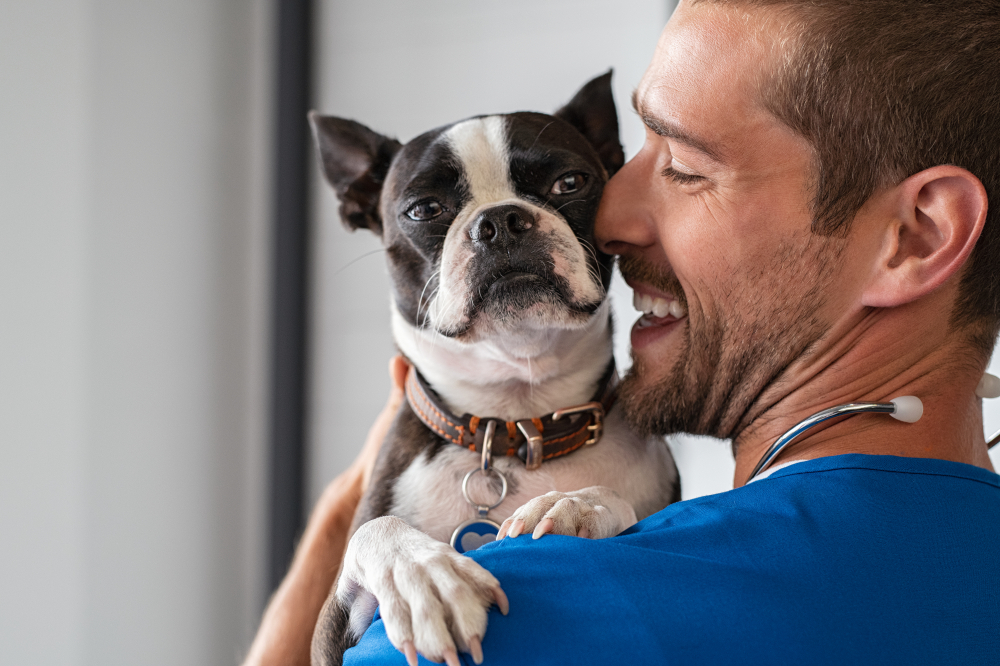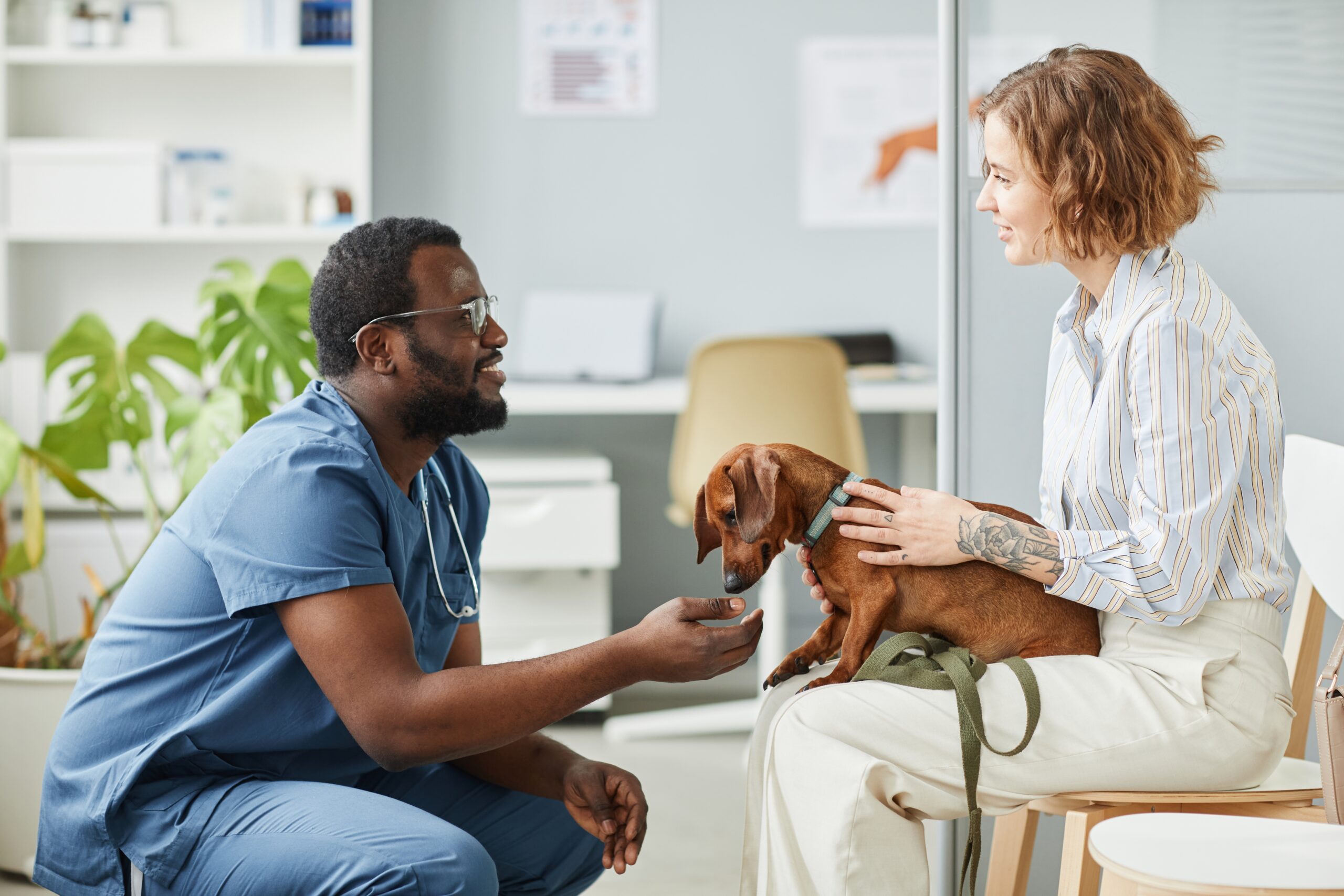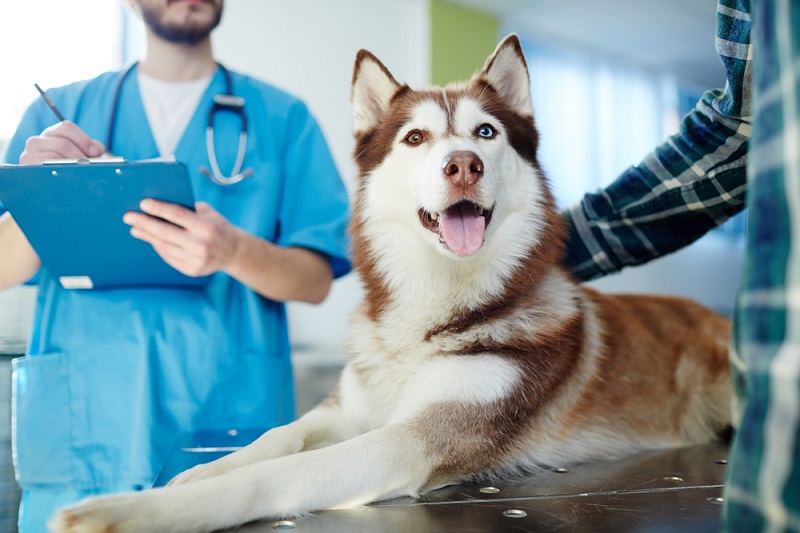There’s nothing quite like adopting a new pet—you get to learn their favorite games to play, shop for the cutest toys and beds, and relish in the fact that you’ll be best friends forever. But in all the excitement, it’s easy to overlook getting a routine care plan in place.
Don’t worry—getting those appointments on the books should be a breeze once you know which are needed and when. So, exactly how often should dogs go to the vet?
This guide breaks down everything you need to know about routine care for dogs, from how often to schedule vet visits to what to expect in the exam room (and which other appointments you should consider making).
A General Timeline for Vet Visits
In general, healthy adult dogs should see the vet for a routine check-up once a year (they’ll receive vaccine boosters at these annual wellness exam check-ups every two to three years).1 However, age or pre-existing conditions might mean that your pup needs additional visits.
For instance, newborn puppies should see the vet at two to three weeks old for a general physical routine exam and to receive dewormer medication, then again at six to eight weeks to receive their first vaccinations, heartworm medication, flea and tick treatment, and a microchip.
After these two initial appointments, your vet may recommend that your puppy return for additional vaccinations and/or check-ups every three to four weeks until they reach 16 weeks old.
Senior dogs also might need to visit the vet more than once a year (per your vet’s recommendation) to receive blood or urine tests to screen for common diseases like diabetes and thyroid disease.
Senior dogs or older dogs are also at higher risk of needing an emergency vet visit should they exhibit concerning symptoms, such as losing weight, peeing more, or startling more easily. All could be symptoms of illnesses like heart disease, osteoarthritis, kidney disease, and more in your senior dog.
If your dog is pregnant, they’ll need a prenatal vet visit—schedule it about two or three weeks after your dog has mated, if possible. To ensure a healthy pregnancy, your vet will:
- Take blood tests
- Perform an ultrasound
- Review your dog’s new nutritional needs
Finally, you’ll need to bring your pregnant pup back to the vet at the onset of the third trimester (around the 45th day of pregnancy). At this point, your vet may recommend additional visits leading up to the birth, and an X-ray will allow them to check on the puppies and determine whether a C-section is necessary.
Ultimately, visiting the vet at least once a year (even when your pup is not due for vaccines that year) is a crucial part of preventive care and your dog’s overall health and wellness plan. Staying up to date on how your dog is doing will help you know their bodies better and keep them healthy as they age.
Plus, receiving parasite treatments and any other necessary prescriptions will help keep your pet comfortable in the face of symptoms you might not notice without the help of a vet.2

What to Expect at Each Vet Visit
Interestingly, vet visits are similar to your own physical exams in that they generally follow the same routine every time.
Medical History
Vet visits typically begin with a review of your pet’s medical history and current state of health.3 You’ll be asked a series of questions about your pet’s diet, exercise habits, thirst levels, and bathroom habits, as well as whether you’ve noticed unusual symptoms. All of this information will be entered into your pet’s file for future reference.
Physical Exam
The meat and potatoes of any vet visit is the physical exam. This part is what you’d imagine when you picture a check-up. Your vet will check on a variety of aspects of your pet’s health, including:
- Weight, stance, and gait
- Temperature
- Heart and lungs (with a stethoscope)
- Eyes for symptoms like redness, discharge, and eyelid issues
- Ears for signs of infection, polyps, etc.
- Coat for dandruff and hair loss
- Teeth for signs of periodontal disease and decay
- Skin for dryness, lumps, etc.
- Abdomen for signs of discomfort or organ abnormalities
- Feet and nails for damage (they may cut the nails upon request or their recommendation)
This thorough process will give the vet a holistic view of your pet’s current state and might unveil issues and symptoms that are not visible to the untrained eye.
Vaccinations and Parasite Prevention
Your pup will generally receive several vaccines in puppyhood and boosters every two to three years in adulthood. The two primary vaccines dogs receive are the rabies inoculation and the DHPP (or DAPP) core vaccine, which covers a variety of diseases, including:
- Kennel cough
- Distemper
- Hepatitis
- Parvovirus
- Parainfluenza
Your pet will also likely receive prescriptions and/or over-the-counter recommendations for flea, tick, and heartworm prevention treatments.
Potential Additional Testing
Other wellness tests might be recommended by your vet depending on your pup’s age, breed, and condition. These tests might include a blood test, a urine test, or a thyroid hormone test. Giant breeds might also require more regular X-rays to monitor their growth.
Reasons for Additional Vet Visits
In addition to annual check-ups, it’s crucial to take your pet to see the vet if you notice any unusual symptoms, such as4:
- A change in eating habits
- Excessive thirst
- A change in eye appearance, or squinting and/or pawing at the eyes
- Vomiting
- Fatigue/lethargy
- Sudden weight loss
- Rear-end scooting
- A change in the appearance or texture of stool (i.e. diarrhea for more than 24 hours, dry stool, mucus/worms/blood in stool)
Any of these symptoms could indicate that your pet is sick and in need of veterinary care. You should also visit the vet if your pet is injured, or if you suspect an injury (i.e. they’re favoring one front or back leg).

When to Visit an Emergency Vet
Think doctor’s office versus the E.R.: certain symptoms might indicate that your pup is in need of immediate attention. If it’s an emergency, visit a local emergency vet clinic immediately. Examples of this type of situation include:
- Seizure
- Collapse or unconsciousness
- Vomiting for over an hour straight (or vomiting blood)
- Bleeding from the mouth, nose, or eyes
- Labored breathing
- Inability to urinate
- Trouble delivering puppies
- Pale gums
- Disorientation
- Serious injury or wounds
- Ingestion of something toxic to dogs (whether it’s rat poison or chocolate)
Remember, it’s always better to be safe than sorry—if you notice any of these symptoms, your vet is always a phone call away and can advise you from afar on whether an E.R. visit is the best course of action.
Other Routine Care for Your Dog
When scheduling your healthy adult dog’s annual physical, it’s a good idea to add other necessary appointments to your pup’s calendar as well. These can include:
Dental Care
Your pet should have their teeth cleaned around once a year. This can typically be done at your vet appointment or at a separate appointment by a veterinarian or vet tech, but certified veterinary dentists exist as well.5>/sup>
Teeth cleanings for dogs are done under anesthesia, as the procedures can be stressful and painful for pets, and they might react by squirming (which can be dangerous around dental tools) or biting.
Grooming
The ASPCA recommends that dogs are bathed at least once every three months, whether that’s by a professional groomer or in your shower or kitchen sink.6
Dogs should also be clipped and groomed every four to six weeks—err on the side of four weeks if their coat is longer or more high-maintenance (i.e. curly or silky).
You can groom your dog at home with some basic tools like scissors, brushes, nail clippers, dog shampoo, and a blow dryer, or invest in professional grooming sessions.
Nutritional Consultations
Don’t forget to regularly check in with your vet about your dog’s diet. They might recommend a specific type or brand of pet food based on your pet’s age, preferences, and any new symptoms that may indicate an allergy.
For a more in-depth, personalized approach, there’s always the option of a consultation with a pet nutritionist. Especially if your pet is obese or requires a homemade diet, a nutritionist can give your pet a full dietary analysis, help you develop a specialized eating plan, and offer you a set of recipes.7
How Much Does a Vet Visit Cost?
The average cost of a vet visit in the U.S. is $61, and vaccines cost about an additional $30 each.8 However, keep in mind that costs may vary according to:
- Your location
- Your pet’s age, gender, and general health
- Whether any additional testing or services were required (i.e. bloodwork or a teeth cleaning)
You can also expect to incur certain one-time costs as a dog owner, such as spaying (around $500) or neutering (around $400), or even treatment for arthritis (around $700) or a broken bone (around $2,700).
Pet Insurance
To help offset this annual expense, it might be a wise idea to invest in pet insurance. Pet insurance works similarly to medical insurance for humans—you’ll likely have a deductible to meet, after which a certain percentage of veterinary costs will be reimbursed.
Generally speaking, you can choose between an accident-only plan or an accident-and-illness plan. You might also choose to add on general wellness coverage so that dental cleanings, vaccines, and other routine procedures are covered, too.

Boost Your Routine Care Plan with ALL-IN
Regular trips to the vet are an investment in your pet’s overall well-being. They act as preventive care to ensure a long and happy life together. But keeping up with a wellness routine between visits is just as vital to boosting your dog’s overall health.
Fortunately, doing so is easy with Vetericyn’s pet care products, like ALL-IN.
ALL-IN is a supplement for dogs that works just like a daily multivitamin. It’s packed with all-natural ingredients like collagen, fish oil, and beet root powder to support your pet’s health holistically, from muscle and bone health to gut health to stress management (and more). Plus, it’s available in puppy, adult, and senior formulas to support your pet no matter their stage of life (and no matter their frequency of vet visits).
Shop ALL-IN dog supplements today to start enhancing your pet’s overall care routine.
Sources:
- Forbes. How Often Should I Take My Dog to the Vet? https://www.forbes.com/advisor/pet-insurance/pet-care/how-often-to-take-dog-to-vet/
- American Kennel Club. How Often Should I Take My Dog to the Vet? https://www.akc.org/expert-advice/health/how-often-should-i-take-my-dog-to-the-vet/
- American Pet Hospital. What to Expect at the Veterinarian’s Office. https://www.modestovethospital.com/site/blog/2021/10/18/what-to-expect-at-vet-appointment
- American Kennel Club. When Should I Call the Vet? https://www.akc.org/expert-advice/health/should-i-call-my-dogs-vet/
- American Veterinary Medical Association. Pet dental care. https://www.avma.org/resources-tools/pet-owners/petcare/pet-dental-care
- Western Technical College. FAQ—All About Dog Grooming. https://cis2.westerntc.edu/halee/web-design-1/2015/roxl/grooming-faq.html
- Cornell University College of Veterinary Medicine. Nutrition. https://www.vet.cornell.edu/hospitals/services/nutrition
- Forbes. How Much Does a Vet Visit Cost? https://www.forbes.com/advisor/pet-insurance/pet-care/how-much-does-vet-visit-cost/